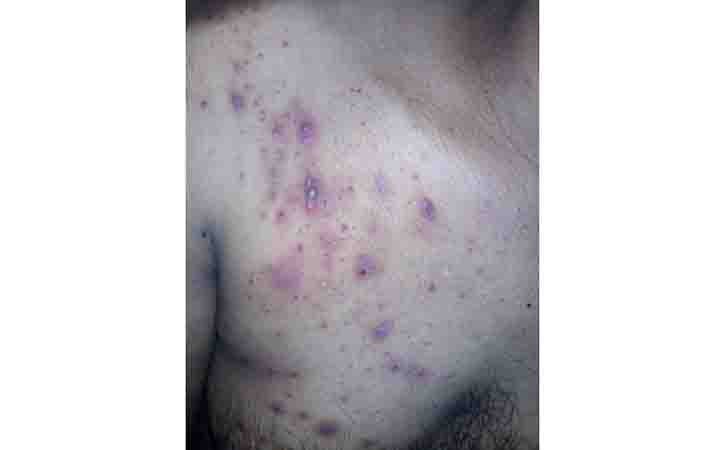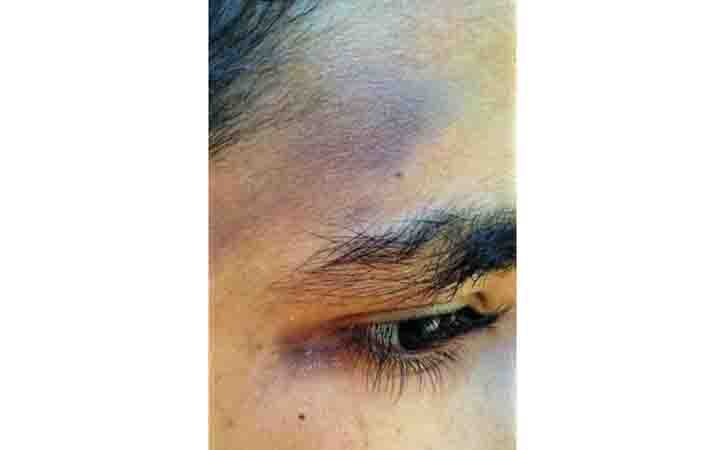Drug Eruptions
Drug reactions are unwanted and unexpected reactions occurring in the skin and sometimes other organ systems that may result from taking medication for the prevention, analyze or treatment of a medical problem. Drug eruptions can mimic a wide range of dermatoses. The morphologies are myriad and include morbilliform (common), urticarial, papulosquamous, pustular, and bullous. Medications can also cause pruritus and dysesthesia without an obvious eruption. Both calcium channel blockers and interferon are strongly associated with eczematous eruptions.
A drug-induced reaction should be considered in any patient who is taking medications and who suddenly develops a symmetric cutaneous eruption. Medications that are known for causing cutaneous reactions include antimicrobial agents, nonsteroidal anti-inflammatory drugs (NSAIDs), cytokines, chemotherapeutic agents, anticonvulsants, and psychotropic agents.
Prompt identification and withdrawal of the offending agent may help limit the toxic effects associated with the drug. The decision to discontinue a potentially vital drug often presents a dilemma.
Drug eruptions occur in approximately 2-3% of inpatients and in greater than 1% of outpatients.
Adverse cutaneous reactions to drugs are more prevalent in women than in men.
Elderly patients have an increased prevalence of adverse drug reactions.

The use of synthetic pharmaceuticals and biopharmaceuticals in medicine has revolutionized human health, allowing us to live longer lives. As a consequence, the average human adult is exposed to a large number of drugs over longer treatment periods throughout a lifetime. This unprecedented rise in pharmaceutical use has led to an increasing number of observed adverse drug reactions.
The first steps in history are as follows:
- Review the patient’s complete medication list.
- Document any history of previous adverse reactions to drugs or foods.
- Consider alternative etiologies (like: viral exanthems and bacterial infections).
- Note any concurrent infections, metabolic disorders, or immunocompromise.
In addition, the following should be noted and detailed:
- The interval between the introduction of a drug and the onset of the eruption.
- Route, dose, duration, and frequency of drug administration.
- Use of parenterally administered drugs (more likely to cause anaphylaxis).
- Use of topically applied drugs (more likely to induce delayed-type hypersensitivity).
- Use of multiple courses of therapy and prolonged administration (risk of allergic sensitization).
- Any improvement after drug withdrawal and any reaction with readministration.
Physical examination should address clinical features that may indicate a severe, potentially life-threatening drug reaction, including the following: Mucous membrane erosions, Blisters, Nikolsky sign, Confluent erythema, Angioedema and tongue swelling, Palpable purpura, Skin necrosis, Lymphadenopathy, High fever, dyspnea, or hypotension



Drugs taken orally, injected, delivered by patch application, rubbed onto the skin (e.g. creams, ointments and lotions) can all cause reactions. The appearance of drug eruptions varies depending on the mechanism of the drug reaction.
Fibrosing reactions have been associated with a variety of chemical exposures. Nephrogenic systemic fibrosis has been associated with gadolinium contrast agents that used for MRI studies. Individuals with renal failure may have a buildup gadolinium in the skin and other organs and may recruit CD34-positive bone marrow-derived fibrocytes into lesional areas. Toxic oil ingestion has been associated with morphea, and Texier disease has been associated with phytomenadione (vitamin-K1) injections.
Name some drugs that occur reactions are: Amoxicillin, Trimethoprim-sulfamethoxazole, Ampicillin, Semisynthetic penicillin, Blood (human), Penicillin G, Cephalosporins, Quinidine, Gentamicin sulfate, Packed red blood cells, Mercurial diuretics, Heparin.
Drugs that commonly cause serious reactions are Allopurinol, Anticonvulsants, NSAIDs, Sulfa drugs, Bumetanide, Captopril, Furosemide, Penicillamine, Piroxicam, Thiazide diuretics,
Drugs unlikely to cause skin reactions are: Digoxin, Meperidine, Acetaminophen, Diphenhydramine hydrochloride, Aspirin, Aminophylline, Prochlorperazine, Ferrous Sulfate, Prednisone, Codeine, Tetracycline, Morphine, Regular insulin, Warfarin, Folic acid, Methyldopa, Chlorpromazine, Serotonin-specific reuptake inhibitors, Topical gels (like 4% tetracaine gel).
If a drug reaction is suspected, the suspected drug or drugs should be discontinued.
Treatment options depend on the nature and severity of the reaction. In an uncomplicated case, once the offending drug is withdrawn the condition is expected to improve.
Depending on the severity of skin lesions, may using emollients under wet dressings, topical or oral steroids, oral antihistamines, other medications or immunosuppressants, or hospitalization.
When a symptom arises, must consult with a doctor. Even, a delay will make costly.
- Clinical Dermatology
- Roxburgh’s common skin diseases
Drug Eruptions
TUI - Tibot Urgency Index


Drug reactions are unwanted and unexpected reactions occurring in the skin and sometimes other organ systems that may result from taking medication for the prevention, analyze or treatment of a medical problem. Drug eruptions can mimic a wide range of dermatoses. The morphologies are myriad and include morbilliform (common), urticarial, papulosquamous, pustular, and bullous. Medications can also cause pruritus and dysesthesia without an obvious eruption. Both calcium channel blockers and interferon are strongly associated with eczematous eruptions.
A drug-induced reaction should be considered in any patient who is taking medications and who suddenly develops a symmetric cutaneous eruption. Medications that are known for causing cutaneous reactions include antimicrobial agents, nonsteroidal anti-inflammatory drugs (NSAIDs), cytokines, chemotherapeutic agents, anticonvulsants, and psychotropic agents.
Prompt identification and withdrawal of the offending agent may help limit the toxic effects associated with the drug. The decision to discontinue a potentially vital drug often presents a dilemma.
Drug eruptions occur in approximately 2-3% of inpatients and in greater than 1% of outpatients.
Adverse cutaneous reactions to drugs are more prevalent in women than in men.
Elderly patients have an increased prevalence of adverse drug reactions.



The use of synthetic pharmaceuticals and biopharmaceuticals in medicine has revolutionized human health, allowing us to live longer lives. As a consequence, the average human adult is exposed to a large number of drugs over longer treatment periods throughout a lifetime. This unprecedented rise in pharmaceutical use has led to an increasing number of observed adverse drug reactions.
The first steps in history are as follows:
- Review the patient’s complete medication list.
- Document any history of previous adverse reactions to drugs or foods.
- Consider alternative etiologies (like: viral exanthems and bacterial infections).
- Note any concurrent infections, metabolic disorders, or immunocompromise.
In addition, the following should be noted and detailed:
- The interval between the introduction of a drug and the onset of the eruption.
- Route, dose, duration, and frequency of drug administration.
- Use of parenterally administered drugs (more likely to cause anaphylaxis).
- Use of topically applied drugs (more likely to induce delayed-type hypersensitivity).
- Use of multiple courses of therapy and prolonged administration (risk of allergic sensitization).
- Any improvement after drug withdrawal and any reaction with readministration.
Physical examination should address clinical features that may indicate a severe, potentially life-threatening drug reaction, including the following: Mucous membrane erosions, Blisters, Nikolsky sign, Confluent erythema, Angioedema and tongue swelling, Palpable purpura, Skin necrosis, Lymphadenopathy, High fever, dyspnea, or hypotension



Drugs taken orally, injected, delivered by patch application, rubbed onto the skin (e.g. creams, ointments and lotions) can all cause reactions. The appearance of drug eruptions varies depending on the mechanism of the drug reaction.
Fibrosing reactions have been associated with a variety of chemical exposures. Nephrogenic systemic fibrosis has been associated with gadolinium contrast agents that used for MRI studies. Individuals with renal failure may have a buildup gadolinium in the skin and other organs and may recruit CD34-positive bone marrow-derived fibrocytes into lesional areas. Toxic oil ingestion has been associated with morphea, and Texier disease has been associated with phytomenadione (vitamin-K1) injections.
Name some drugs that occur reactions are: Amoxicillin, Trimethoprim-sulfamethoxazole, Ampicillin, Semisynthetic penicillin, Blood (human), Penicillin G, Cephalosporins, Quinidine, Gentamicin sulfate, Packed red blood cells, Mercurial diuretics, Heparin.
Drugs that commonly cause serious reactions are Allopurinol, Anticonvulsants, NSAIDs, Sulfa drugs, Bumetanide, Captopril, Furosemide, Penicillamine, Piroxicam, Thiazide diuretics,
Drugs unlikely to cause skin reactions are: Digoxin, Meperidine, Acetaminophen, Diphenhydramine hydrochloride, Aspirin, Aminophylline, Prochlorperazine, Ferrous Sulfate, Prednisone, Codeine, Tetracycline, Morphine, Regular insulin, Warfarin, Folic acid, Methyldopa, Chlorpromazine, Serotonin-specific reuptake inhibitors, Topical gels (like 4% tetracaine gel).
If a drug reaction is suspected, the suspected drug or drugs should be discontinued.
Treatment options depend on the nature and severity of the reaction. In an uncomplicated case, once the offending drug is withdrawn the condition is expected to improve.
Depending on the severity of skin lesions, may using emollients under wet dressings, topical or oral steroids, oral antihistamines, other medications or immunosuppressants, or hospitalization.
When a symptom arises, must consult with a doctor. Even, a delay will make costly.
- Clinical Dermatology
- Roxburgh’s common skin diseases




